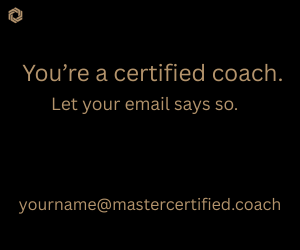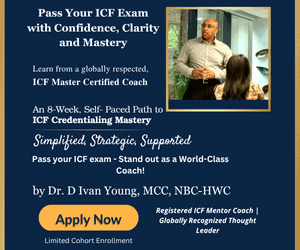The message stood out in my inbox.
“HELP!” it commanded.
My curiosity piqued, I opened it to read the brief story of someone who’d recently found himself in a new leadership role and wanted coaching support. We set up an introductory call for the next day. By the call’s end, he’d enrolled as a client.
It was clear that he was driven, goal oriented, and had a strong personality. I don’t remember if he called himself an “alpha male” or if I mentally applied the label. Either way, there was a certain energy he projected that told me he was going to be an interesting client. Never one to shy away from interesting, I thought, “I can handle this!”
And besides, my roster was a bit thin at the time, so a new client was a welcome relief.
As you’re reading this, do you see what I see?
You’re seeing what I missed (or ignored) at the time: The “HELP!” subject line should have been an immediate red flag. He enrolled too quickly before talking to other coaches. A challenging client is one thing, but if from the get-go, I’m thinking, “I can handle this,” well…it’s not an ideal mindset. And finally, setting aside those warning signals because of a light roster? By now, you should be facepalming like crazy.
By the third session, I knew without a doubt that we weren’t a good fit. Sure, there were glimpses of connection and movement that offered slivers of hope. And I reasoned with myself, thinking, “This is an opportunity to shore up my weak areas as a coach. He’s my client for a reason.” (Are you catching this bonus red flag!?)
I was hoping he would be the first to say it wasn’t working. As it turns out, I had to break it off. Because of his communication style, I decided to do it through email, which proved to be the right choice. In the end, there was no ill will, only lessons learned.
Yet despite those lessons, in the years since, I’ve found myself in two more client mismatches. Except each time, I realized it more quickly and was able to bring the relationship to completion through conversation. In one case, the client wanted more consultation than coaching. In the other, I came to believe the business model they were attached to wasn’t viable, and I couldn’t see a way forward.
The truth is, despite your best efforts, client mismatches will happen. How can you avoid them? The short answer: Clearly define your ideal client. Develop strong agreements and mutual expectations. Don’t say “yes” from desperation. Trust your intuition. Be willing to say up front, “We’re not a good fit.”
What happens when everything looks good on paper and starts out promising, but a few sessions into it, you realize you’re not two peas in a pod? The new ICF Core Competency Model explicitly states that we are expected to “partner with the client to end the coaching relationship in a way that honors the experience.” How do we do that?
Identify the Breakdown
Where did you get the first red flags?
What was your rationale for moving ahead anyway?
Where was the disconnect?
Was the root cause a one-off issue, or is it a pattern?
Own What’s Yours
It’s fair to consider how each of you played a role in the situation. Maybe the agreement was fuzzy. Perhaps their needs shifted. Even with best intent, mistakes happen. Knowing where the partnership was not set up for success is helpful when deciding what to say to the client, as well as in establishing new agreements with future clients.
Be Compassionate with Yourself
Resist judging yourself harshly, especially if you discover you were coming from financial scarcity. Name it, claim it, but don’t shame it.
Co-create the Completion
Ask your client how they would like to bring the partnership to a close? What do they need to feel complete? Consider those same questions for yourself. Treat the conversation as an opportunity to offer continued value by staying curious, leaving space for new learning, and offering appreciation. If appropriate, acknowledge and celebrate whatever results the client experienced.
Reflect on What You Learned
Even if you know it’s the right thing to do, you can still doubt your abilities. It’s true that we can always identify areas for skill-building, and it’s most powerful to build those skills when you are working with your ideal clients.
Practice Gratitude
For every client mismatch, there are 10 more that put you in your coaching happy place. Be grateful for all of them. Experiencing the occasional dissonance makes the resonance sing brighter.
Rich, rewarding coaching partnerships happen when there’s mutual trust, respect, safety and commitment. Don’t settle for anything less. You both deserve to have it all!
Disclaimer
The views and opinions expressed in guest posts featured on this blog are those of the author and do not necessarily reflect the opinions and views of the International Coach Federation (ICF). The publication of a guest post on the ICF Blog does not equate to an ICF endorsement or guarantee of the products or services provided by the author.
Additionally, for the purpose of full disclosure and as a disclaimer of liability, this content was possibly generated using the assistance of an AI program. Its contents, either in whole or in part, have been reviewed and revised by a human. Nevertheless, the reader/user is responsible for verifying the information presented and should not rely upon this article or post as providing any specific professional advice or counsel. Its contents are provided “as is,” and ICF makes no representations or warranties as to its accuracy or completeness and to the fullest extent permitted by applicable law specifically disclaims any and all liability for any damages or injuries resulting from use of or reliance thereupon.
Authors
Post Type
Blog
Audience Type
Experienced Coaches, External Coaches, ICF Chapter Leaders, Internal Coaches, Mentor Coaches, New Coaches, Professional Coaches, Team and Group Coaches
Topic
Building a Successful Coaching Business, Business Development
Related Posts
The Executive Coaching Blueprint: Positioning, Pricing, and Performance
Transitioning from corporate to coach can feel like uncharted territory for many…
Why Coaches Need Other Coaches
Setting the Foundation When you’re learning about the field of coaching while…
Expanding Coaching Possibilities With the Coaching Spectrum Framework™
When I discovered coaching 14 years into my career as an occupational…








